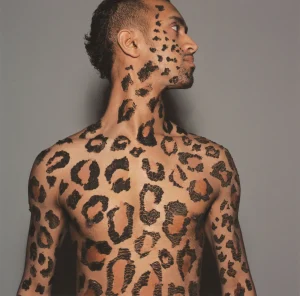Before The Art House established its permanent space in Wakefield, the arts organisation supported emerging artists through residencies and exhibitions at partner venues. In 2023, TAH supported Hetain Patel with his first solo exhibition, A Third Place, at 20/21 Visual Arts Centre in Scunthorpe. The exhibition explored the complexities of cultural identity and the intersection of different worlds.
During a three-month residency, Patel worked with materials traditionally used in Hindu prayer and marriage ceremonies, such as Henna and Kanku paste to paint his torso with patterns derived from both Hindi (mehndi, the intricate patterns painted on hands and feet) and Western cultures, to question ideas of cultural identity and ‘sense of self’.
Patel also explored other patterns associated with identity, such as the markings on a leopard – questioning whether it is possible to ‘change one’s spots’. What makes each animal unique can also act as camouflage, integrating the individual into their surroundings in one context. However, that patterning can make an individual stand out in other environments.
Patel’s Sacred Bodies series blends photographic self-portraiture with a strong performative element, exploring the intersection of personal identity, ritual, and cultural symbolism. In this body of work, Patel draws deeply from the traditions and ceremonies of his South Asian upbringing, using the pigments as significant markers of his Indian heritage. Patel documented the process of painting the body on film over many hours – reflecting the time it takes for Hindu marriage ceremonies. These intricate patterns are applied with great care and attention.
Through this process, Patel transforms his body into a living canvas, exploring the tension between tradition and identity as he reclaims and reinterprets cultural symbols in a modern, personal context.



Hetain also ran workshops with local youth groups, encouraging them to think about what they wear that identifies them. He worked with the group to create Hidden Identities, a coinciding exhibition that explored dress codes and the impact of conventional clothing and a sense of self.



